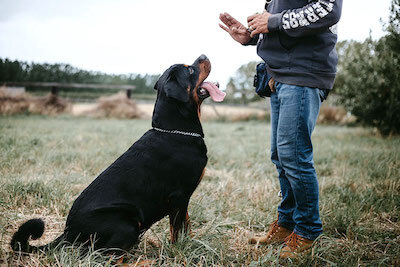A Simple and Incredibly Effective Dog Training Tip for Dog Owners
©Scott Sheaffer, CDBC, CBCC-KA, CPDT-KA, USA Dog Behavior, LLC
“You will enjoy how much more enthusiastic your dog is when you ask him or her to perform these trained behaviors…”
It seems like some of the most effective dog training advice I provide dog owners is actually fairly simple. The following is an example of a tip that is simple but extremely powerful when training your dog at home.
Dog Training Basics
Before I provide the details of the tip, let’s first establish that positive rewards training (versus punishment) has been shown to be the best way to train a dog to do just about anything. Further, the results of training this way are longer lasting and simultaneously enhance the relationship between owner and dog. I could go on and on about the benefits.
Positive Rewards Training
What is positive rewards training? Briefly stated, it’s the time tested and scientifically sound method of using rewards to train dogs to do our bidding. These rewards can be food, affection or play; the most commonly used reward is food (e.g., training treats).
It works by teaching the dog that if he or she complies with a cue (i.e., “command”) he or she will be rewarded. The sequence is: cue (e.g., “sit”) - - > desired behavior (e.g., sitting) - - > reward (e.g., training treat). Timing, patience and consistency are super important when doing this. Over time, the reward frequency can be reduced although never completely eliminated.
Please see an experienced dog trainer who uses positive rewards training methods to get more information on how to do this properly. Another good place to learn more is by attending a high-quality dog training class that uses these same techniques.
Don’t Be Judgmental
I know what some of you are thinking. “My dog should do what I ask without rewards.” My response, “how often would you go to work if you stopped getting paid?” All living things need motivation to do things they wouldn’t normally do on their own.
And Now, the Dog Training Tip
Most people who use positive rewards when training their dog use training treats and keep these treats in one single location in their home.
Can you see where I’m going with this? “One single location” is the issue. Your dog learns that unless you are in that location, he or she is probably not going to get a reward for doing something that you ask him or her to do. Dogs figure this out by what we call “backchaining”. Dogs are smart; they quickly learn that to get a treat the following must occur in this order: 1) you’re in a certain location, 2) you request a behavior, 3) they comply with your cue.
In short, if you’re not where the treats are, they aren’t immediately motivated to learn and do new things for you.
The Fix
Hide treats in multiple locations inside and outside your home so you can easily access them when needed. Make sure they are hidden well and are kept in sealed containers so they don’t dry out.
When you are at these various locations ask your dog for a “come”, for example. You will get a kick out of how amazed your dog is when he or she comes to you at a random location and, voila, you produce a treat! Suddenly your dog will pay a lot more attention when you ask him or her to come to you regardless of where you are.
Ask your dog for “sit”, “stay” and “down” and any other cues you are training your dog to do from these various locations. You will enjoy how much more enthusiastic your dog is when you ask him or her to perform these trained behaviors from a multitude of locations.
Your dog doesn’t know where the good stuff is coming from. And he or she loves the game.
You can carry treats around with you instead of locating them in random places. However, I’ve found that when dogs see you head to your standard treat location to load up on treats before going to other locations for training, this only slightly modifies the existing backchaining problem.
Final Thoughts
It goes without saying that these secretive locations for treats need to be rotated occasionally. Also, slowly begin to reduce how often you reward the behavior but don’t ever completely eliminate the rewards. As mentioned above, see a qualified positive rewards dog trainer or dog training school for more information on training your dog to reliably perform cues.

